MEM 501: Corani Project Mine Design and Feasibility Study
VerifiedAdded on 2022/08/13
|6
|1150
|26
Homework Assignment
AI Summary
This assignment analyzes the feasibility study of the Corani project, focusing on the mine design and resource model developed. The study determines block height based on dilution versus bench height and considers mining equipment. It examines rock types, including barren, economic interest, and potential mineralization, and explains the linear kriging method used for grade estimation. Density is affected by rock type, not block grade. Resource classification is based on silver grade estimates, kriged standard deviation, and composite numbers. The potential economic pit is determined using the block model and floating cone algorithm. Geological features influence material model design, assisting strategic mine planning. Rock types influence mining equipment selection, with loader-truck systems favored for material shifting. The study references relevant works on mining and feasibility.
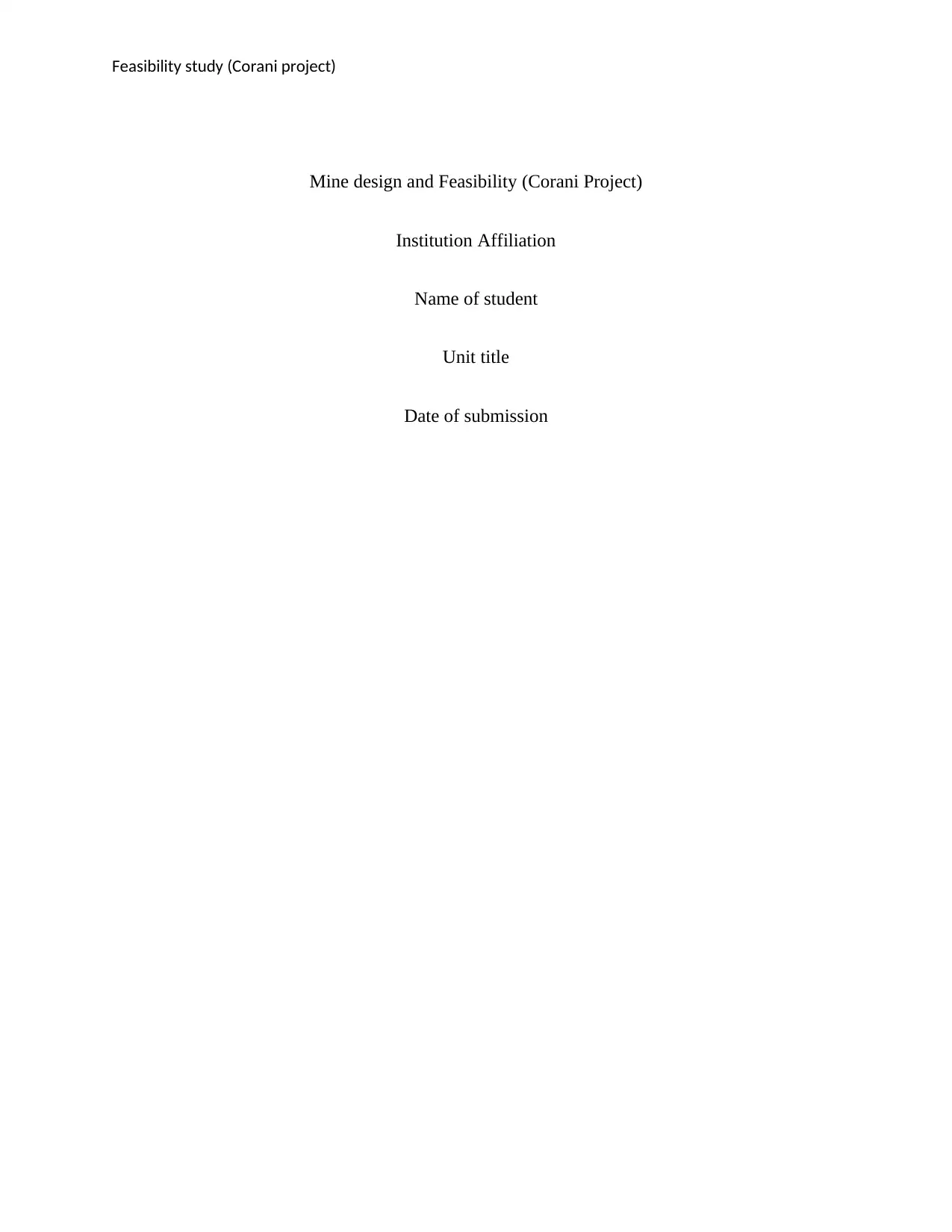
Feasibility study (Corani project)
Mine design and Feasibility (Corani Project)
Institution Affiliation
Name of student
Unit title
Date of submission
Mine design and Feasibility (Corani Project)
Institution Affiliation
Name of student
Unit title
Date of submission
Paraphrase This Document
Need a fresh take? Get an instant paraphrase of this document with our AI Paraphraser
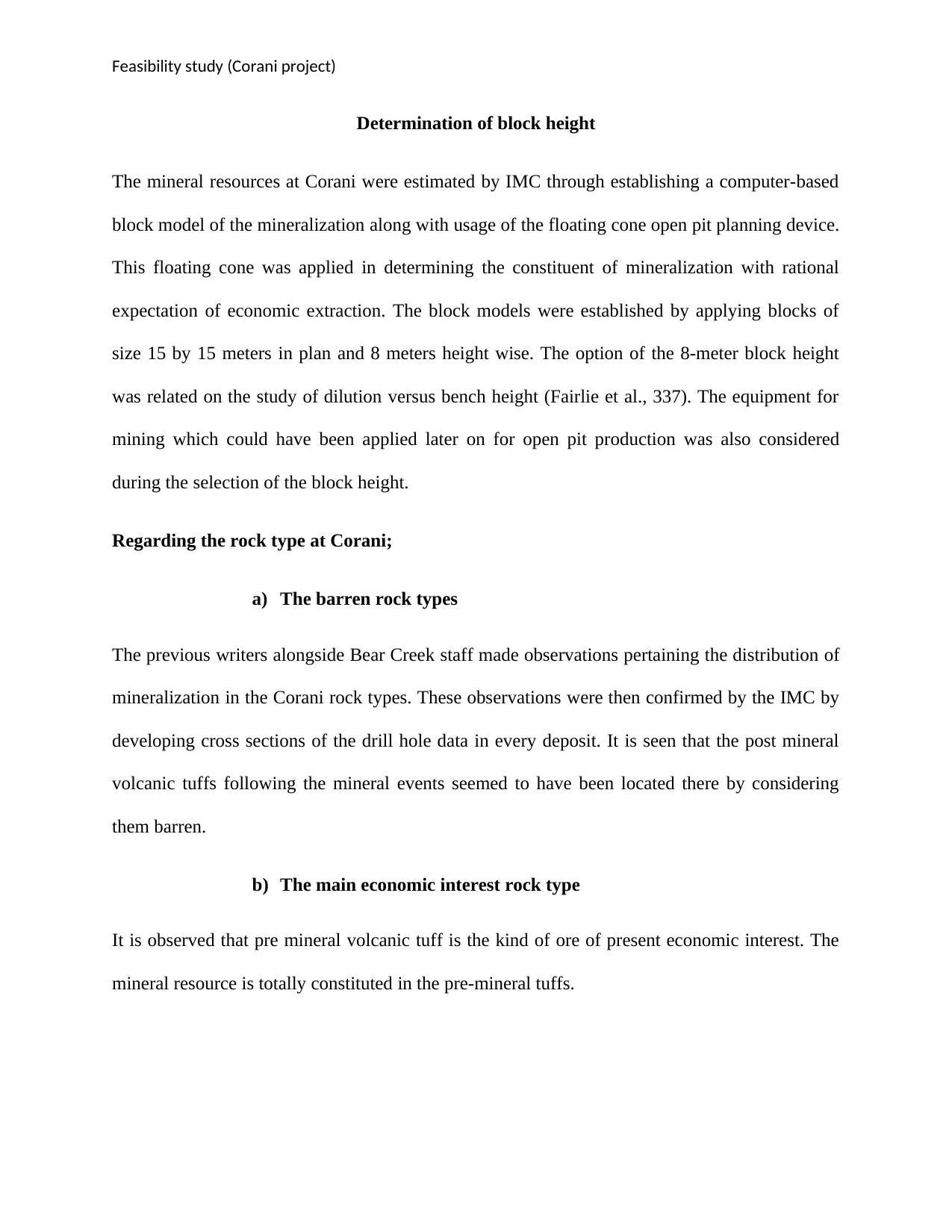
Feasibility study (Corani project)
Determination of block height
The mineral resources at Corani were estimated by IMC through establishing a computer-based
block model of the mineralization along with usage of the floating cone open pit planning device.
This floating cone was applied in determining the constituent of mineralization with rational
expectation of economic extraction. The block models were established by applying blocks of
size 15 by 15 meters in plan and 8 meters height wise. The option of the 8-meter block height
was related on the study of dilution versus bench height (Fairlie et al., 337). The equipment for
mining which could have been applied later on for open pit production was also considered
during the selection of the block height.
Regarding the rock type at Corani;
a) The barren rock types
The previous writers alongside Bear Creek staff made observations pertaining the distribution of
mineralization in the Corani rock types. These observations were then confirmed by the IMC by
developing cross sections of the drill hole data in every deposit. It is seen that the post mineral
volcanic tuffs following the mineral events seemed to have been located there by considering
them barren.
b) The main economic interest rock type
It is observed that pre mineral volcanic tuff is the kind of ore of present economic interest. The
mineral resource is totally constituted in the pre-mineral tuffs.
Determination of block height
The mineral resources at Corani were estimated by IMC through establishing a computer-based
block model of the mineralization along with usage of the floating cone open pit planning device.
This floating cone was applied in determining the constituent of mineralization with rational
expectation of economic extraction. The block models were established by applying blocks of
size 15 by 15 meters in plan and 8 meters height wise. The option of the 8-meter block height
was related on the study of dilution versus bench height (Fairlie et al., 337). The equipment for
mining which could have been applied later on for open pit production was also considered
during the selection of the block height.
Regarding the rock type at Corani;
a) The barren rock types
The previous writers alongside Bear Creek staff made observations pertaining the distribution of
mineralization in the Corani rock types. These observations were then confirmed by the IMC by
developing cross sections of the drill hole data in every deposit. It is seen that the post mineral
volcanic tuffs following the mineral events seemed to have been located there by considering
them barren.
b) The main economic interest rock type
It is observed that pre mineral volcanic tuff is the kind of ore of present economic interest. The
mineral resource is totally constituted in the pre-mineral tuffs.
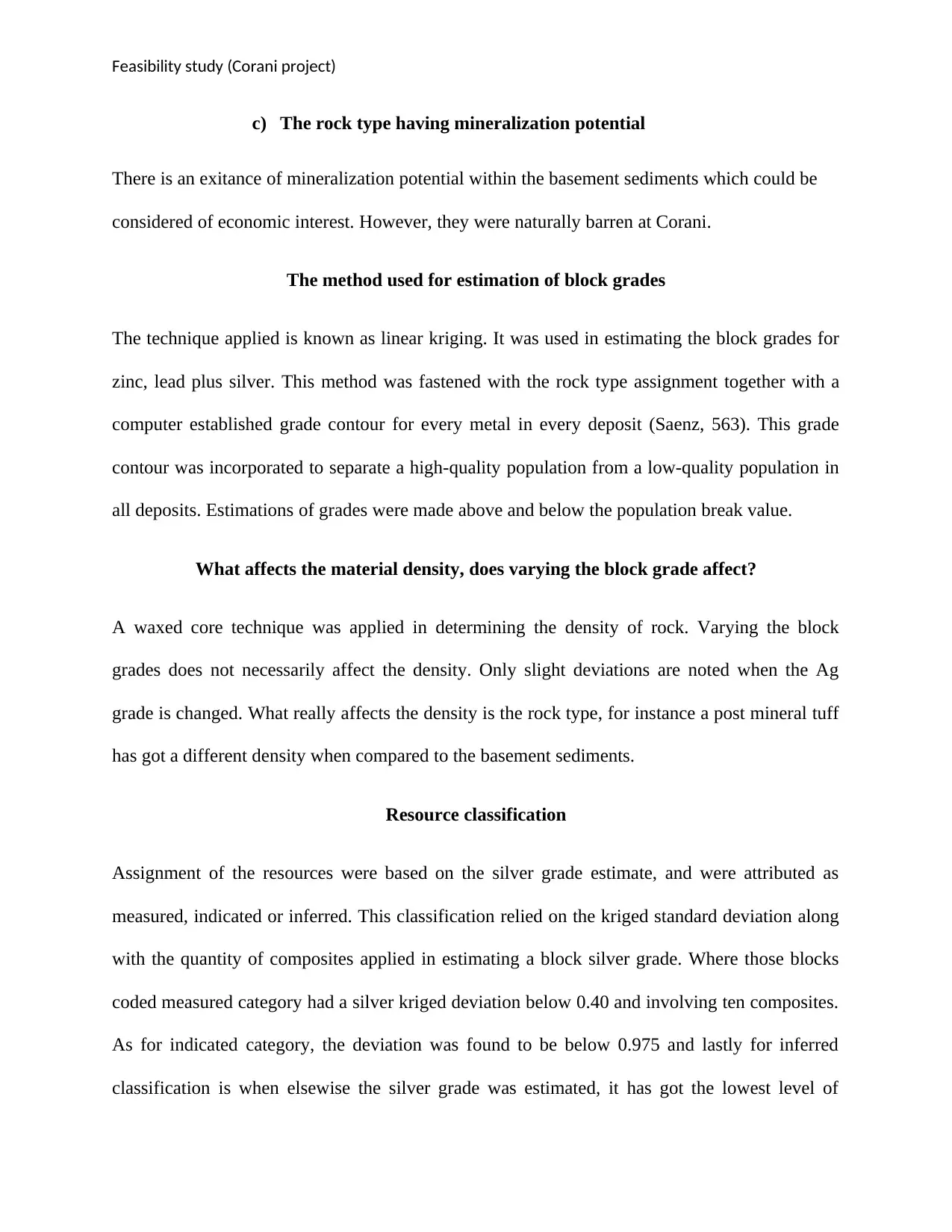
Feasibility study (Corani project)
c) The rock type having mineralization potential
There is an exitance of mineralization potential within the basement sediments which could be
considered of economic interest. However, they were naturally barren at Corani.
The method used for estimation of block grades
The technique applied is known as linear kriging. It was used in estimating the block grades for
zinc, lead plus silver. This method was fastened with the rock type assignment together with a
computer established grade contour for every metal in every deposit (Saenz, 563). This grade
contour was incorporated to separate a high-quality population from a low-quality population in
all deposits. Estimations of grades were made above and below the population break value.
What affects the material density, does varying the block grade affect?
A waxed core technique was applied in determining the density of rock. Varying the block
grades does not necessarily affect the density. Only slight deviations are noted when the Ag
grade is changed. What really affects the density is the rock type, for instance a post mineral tuff
has got a different density when compared to the basement sediments.
Resource classification
Assignment of the resources were based on the silver grade estimate, and were attributed as
measured, indicated or inferred. This classification relied on the kriged standard deviation along
with the quantity of composites applied in estimating a block silver grade. Where those blocks
coded measured category had a silver kriged deviation below 0.40 and involving ten composites.
As for indicated category, the deviation was found to be below 0.975 and lastly for inferred
classification is when elsewise the silver grade was estimated, it has got the lowest level of
c) The rock type having mineralization potential
There is an exitance of mineralization potential within the basement sediments which could be
considered of economic interest. However, they were naturally barren at Corani.
The method used for estimation of block grades
The technique applied is known as linear kriging. It was used in estimating the block grades for
zinc, lead plus silver. This method was fastened with the rock type assignment together with a
computer established grade contour for every metal in every deposit (Saenz, 563). This grade
contour was incorporated to separate a high-quality population from a low-quality population in
all deposits. Estimations of grades were made above and below the population break value.
What affects the material density, does varying the block grade affect?
A waxed core technique was applied in determining the density of rock. Varying the block
grades does not necessarily affect the density. Only slight deviations are noted when the Ag
grade is changed. What really affects the density is the rock type, for instance a post mineral tuff
has got a different density when compared to the basement sediments.
Resource classification
Assignment of the resources were based on the silver grade estimate, and were attributed as
measured, indicated or inferred. This classification relied on the kriged standard deviation along
with the quantity of composites applied in estimating a block silver grade. Where those blocks
coded measured category had a silver kriged deviation below 0.40 and involving ten composites.
As for indicated category, the deviation was found to be below 0.975 and lastly for inferred
classification is when elsewise the silver grade was estimated, it has got the lowest level of
⊘ This is a preview!⊘
Do you want full access?
Subscribe today to unlock all pages.

Trusted by 1+ million students worldwide
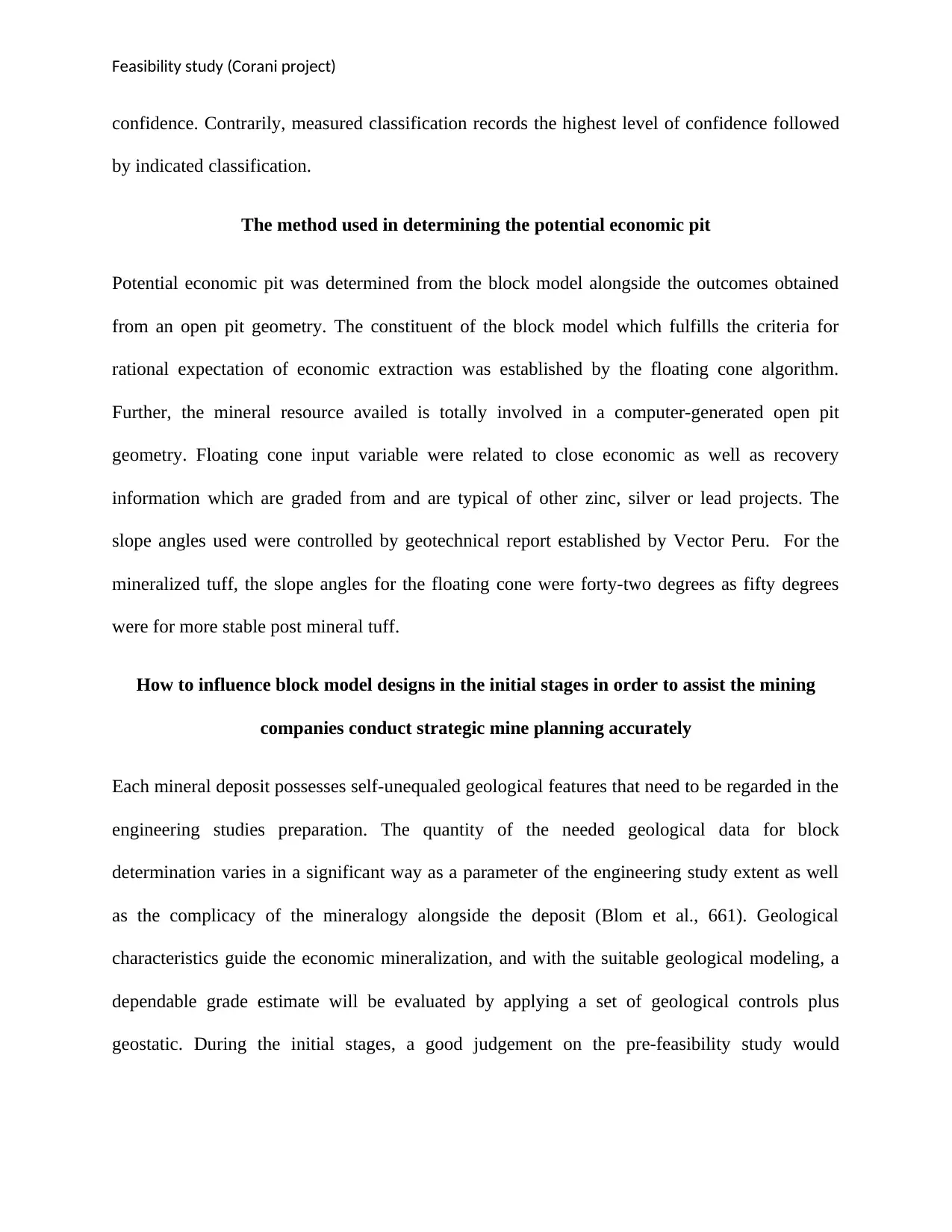
Feasibility study (Corani project)
confidence. Contrarily, measured classification records the highest level of confidence followed
by indicated classification.
The method used in determining the potential economic pit
Potential economic pit was determined from the block model alongside the outcomes obtained
from an open pit geometry. The constituent of the block model which fulfills the criteria for
rational expectation of economic extraction was established by the floating cone algorithm.
Further, the mineral resource availed is totally involved in a computer-generated open pit
geometry. Floating cone input variable were related to close economic as well as recovery
information which are graded from and are typical of other zinc, silver or lead projects. The
slope angles used were controlled by geotechnical report established by Vector Peru. For the
mineralized tuff, the slope angles for the floating cone were forty-two degrees as fifty degrees
were for more stable post mineral tuff.
How to influence block model designs in the initial stages in order to assist the mining
companies conduct strategic mine planning accurately
Each mineral deposit possesses self-unequaled geological features that need to be regarded in the
engineering studies preparation. The quantity of the needed geological data for block
determination varies in a significant way as a parameter of the engineering study extent as well
as the complicacy of the mineralogy alongside the deposit (Blom et al., 661). Geological
characteristics guide the economic mineralization, and with the suitable geological modeling, a
dependable grade estimate will be evaluated by applying a set of geological controls plus
geostatic. During the initial stages, a good judgement on the pre-feasibility study would
confidence. Contrarily, measured classification records the highest level of confidence followed
by indicated classification.
The method used in determining the potential economic pit
Potential economic pit was determined from the block model alongside the outcomes obtained
from an open pit geometry. The constituent of the block model which fulfills the criteria for
rational expectation of economic extraction was established by the floating cone algorithm.
Further, the mineral resource availed is totally involved in a computer-generated open pit
geometry. Floating cone input variable were related to close economic as well as recovery
information which are graded from and are typical of other zinc, silver or lead projects. The
slope angles used were controlled by geotechnical report established by Vector Peru. For the
mineralized tuff, the slope angles for the floating cone were forty-two degrees as fifty degrees
were for more stable post mineral tuff.
How to influence block model designs in the initial stages in order to assist the mining
companies conduct strategic mine planning accurately
Each mineral deposit possesses self-unequaled geological features that need to be regarded in the
engineering studies preparation. The quantity of the needed geological data for block
determination varies in a significant way as a parameter of the engineering study extent as well
as the complicacy of the mineralogy alongside the deposit (Blom et al., 661). Geological
characteristics guide the economic mineralization, and with the suitable geological modeling, a
dependable grade estimate will be evaluated by applying a set of geological controls plus
geostatic. During the initial stages, a good judgement on the pre-feasibility study would
Paraphrase This Document
Need a fresh take? Get an instant paraphrase of this document with our AI Paraphraser
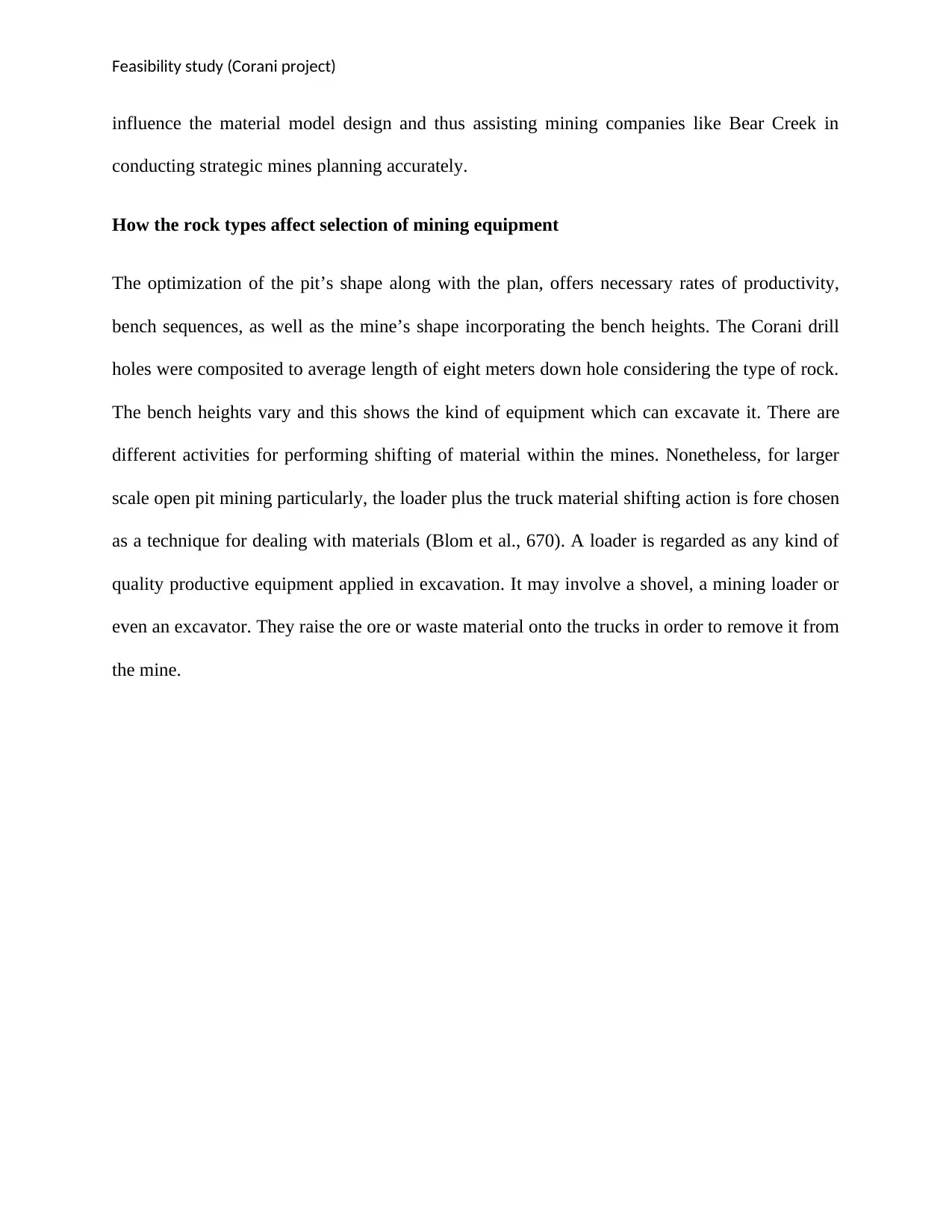
Feasibility study (Corani project)
influence the material model design and thus assisting mining companies like Bear Creek in
conducting strategic mines planning accurately.
How the rock types affect selection of mining equipment
The optimization of the pit’s shape along with the plan, offers necessary rates of productivity,
bench sequences, as well as the mine’s shape incorporating the bench heights. The Corani drill
holes were composited to average length of eight meters down hole considering the type of rock.
The bench heights vary and this shows the kind of equipment which can excavate it. There are
different activities for performing shifting of material within the mines. Nonetheless, for larger
scale open pit mining particularly, the loader plus the truck material shifting action is fore chosen
as a technique for dealing with materials (Blom et al., 670). A loader is regarded as any kind of
quality productive equipment applied in excavation. It may involve a shovel, a mining loader or
even an excavator. They raise the ore or waste material onto the trucks in order to remove it from
the mine.
influence the material model design and thus assisting mining companies like Bear Creek in
conducting strategic mines planning accurately.
How the rock types affect selection of mining equipment
The optimization of the pit’s shape along with the plan, offers necessary rates of productivity,
bench sequences, as well as the mine’s shape incorporating the bench heights. The Corani drill
holes were composited to average length of eight meters down hole considering the type of rock.
The bench heights vary and this shows the kind of equipment which can excavate it. There are
different activities for performing shifting of material within the mines. Nonetheless, for larger
scale open pit mining particularly, the loader plus the truck material shifting action is fore chosen
as a technique for dealing with materials (Blom et al., 670). A loader is regarded as any kind of
quality productive equipment applied in excavation. It may involve a shovel, a mining loader or
even an excavator. They raise the ore or waste material onto the trucks in order to remove it from
the mine.
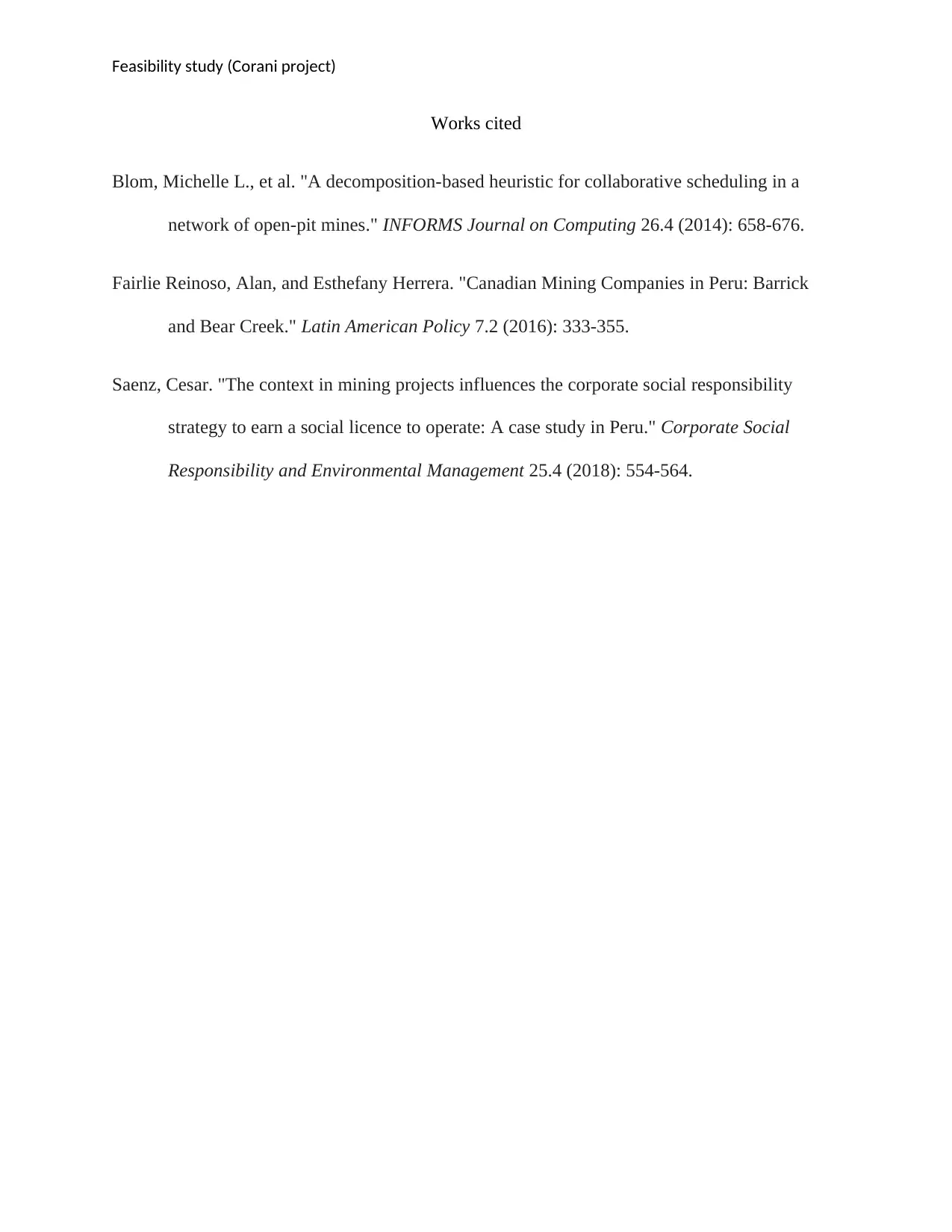
Feasibility study (Corani project)
Works cited
Blom, Michelle L., et al. "A decomposition-based heuristic for collaborative scheduling in a
network of open-pit mines." INFORMS Journal on Computing 26.4 (2014): 658-676.
Fairlie Reinoso, Alan, and Esthefany Herrera. "Canadian Mining Companies in Peru: Barrick
and Bear Creek." Latin American Policy 7.2 (2016): 333-355.
Saenz, Cesar. "The context in mining projects influences the corporate social responsibility
strategy to earn a social licence to operate: A case study in Peru." Corporate Social
Responsibility and Environmental Management 25.4 (2018): 554-564.
Works cited
Blom, Michelle L., et al. "A decomposition-based heuristic for collaborative scheduling in a
network of open-pit mines." INFORMS Journal on Computing 26.4 (2014): 658-676.
Fairlie Reinoso, Alan, and Esthefany Herrera. "Canadian Mining Companies in Peru: Barrick
and Bear Creek." Latin American Policy 7.2 (2016): 333-355.
Saenz, Cesar. "The context in mining projects influences the corporate social responsibility
strategy to earn a social licence to operate: A case study in Peru." Corporate Social
Responsibility and Environmental Management 25.4 (2018): 554-564.
⊘ This is a preview!⊘
Do you want full access?
Subscribe today to unlock all pages.

Trusted by 1+ million students worldwide
1 out of 6
Your All-in-One AI-Powered Toolkit for Academic Success.
+13062052269
info@desklib.com
Available 24*7 on WhatsApp / Email
![[object Object]](/_next/static/media/star-bottom.7253800d.svg)
Unlock your academic potential
Copyright © 2020–2025 A2Z Services. All Rights Reserved. Developed and managed by ZUCOL.